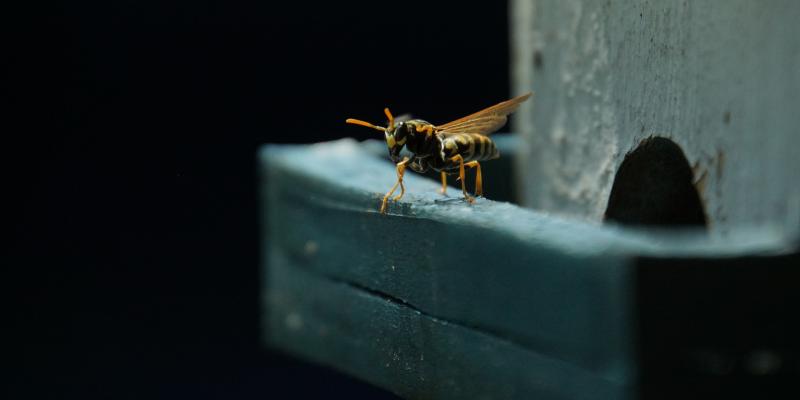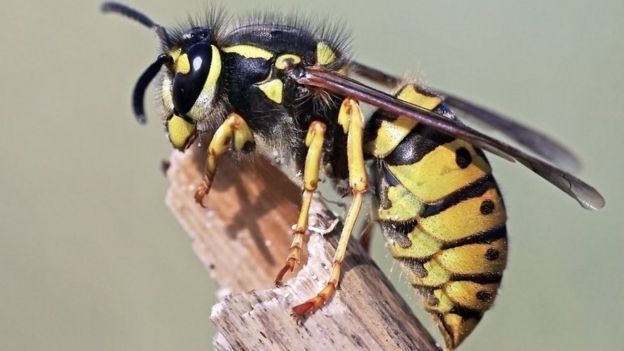HOW TO KEEP WASPS AWAY FROM YOUR HOUSE
environment — wasps tend to have a more negative reception. They can cause a host problems and scare the heck out of your kids when they get in the house! So you may be wondering how to keep wasps away from your house, which is exactly what we’ll cover in this article.
Wasps belong to a different family than bees called Vespidae. They are infamously known for their aggressive nature and painful sting when provoked. Unlike bees, wasps can sting multiple times without hurting themselves as their stingers remain intact similar to bumble bees.
Unfortunately, they also have the tendency to build nests in or around homes and other structures. This makes them a common pest that can be frustrating, and a little scary to deal with.
HOW TO IDENTIFY WASPS
Being able to identify wasps from other insects is important when it comes to successfully deterring them from your home. The Vespidae family includes thousands of species found globally, but the most commonly encountered types of wasps are paper wasps, yellow jackets, and hornets.
Yellow Jackets are probably what come to mind when imagining a wasp. They possess very thin waists ( like all wasps ) and hairless bodies — much different than the fuzzy, thick bodies of honey bees and bumblebees. Because of this, yellow jackets appear shinier and more colorful than bees. Their abdomens are also longer and pointed at the end

Living with bees and wasps
A guide to bees and wasps and solving the problems they may cause
Bees and wasps are probably our most familiar insects, visiting our gardens from spring until autumn. Bees perform a vital role because they pollinate flowers so that we can enjoy apples, tomatoes and flowers each year. Wasps are also useful to gardeners and farmers because they eat many types of insect pests. Bees and wasps are disliked by many people because of their ability to sting or form large swarms.
About bees
Bumble bees are the best known. They look too big to fly and their striped, hairy bodies and familiar ‘buzz’ are an essential part of any garden in summer. There are 25 species in Britain and they are not all striped! They form small colonies of no more than a few hundred individuals. Each colony is headed by the ‘queen bee’ who lays eggs while worker bees collect pollen and nectar to keep the colony supplied. They are very important as pollinators for farmers and gardeners. Honey bees are smaller and less hairy than bumble bees. More than 2,000 beekeepers keep colonies of honey bees. Honeybees form huge colonies of as many as 20,000 individuals, all a single ‘queen’s offspring. As well as honey, beeswax can be obtained from their hives.
About wasps
There are seven species of wasp which form colonies in the UK, including the ‘hornet’. They are all easily identified by their distinctive yellow and black stripes which act as a warning that they sting! Queen wasps hibernate during the winter and start looking for a nest site in spring. They make a nest of paper from chewed up wood fibres and start laying eggs. The wasp larvae are fed on caterpillars, spiders and aphids which the workers catch for them. Worker wasps love to eat nectar or anything sugary, such as rotting fruit. A queen wasp can lay as many as 2,000 eggs each day. No wonder wasp colonies can grow to over 20,000 individuals in just a few weeks!
Solitary bees and wasps
Not all bees and wasps live in colonies. There are more than 200 species of solitary bees and wasps in the UK. Solitary bees lay their eggs in cells hidden away in soft sand, soil or mortar, providing each egg with its own food supply. Perhaps the best known solitary bee is the ‘leaf-cutter’ which is responsible for cutting neat little semi-circles from the leaves and flowers of roses. Solitary wasps lead very similar lives to solitary bees, except that many of them are parasitic, laying their eggs inside the bodies of other insects. The larva then grows inside the living host until it is ready to turn into a wasp. Some solitary wasps are important for controlling many pest species
Bee and wasp problems
Many bees and wasps build large nests which can be home to more than 20,000 insects. They build nests in secluded places such as trees, lofts, sheds, nest boxes and compost heaps. While bees and wasps will defend their nests, they are unlikely to attack you unless you get too close. If possible, it is best to leave their nests well alone. Remember that bumble bees will never attack you if left alone. If you want a bumble bee nest removed, you should only use experts. We do not provide this service so you should contact your local beekeepers association for advice. Pest controllers usually destroy wasp nests as they are difficult to relocate. We provide this service for a fee

Overwintered Wasps
General Information About Overwintering Paper Wasps
Wasps such as yellow jackets and paper wasps seen at this time of the year are over-wintering queens produced by colonies last fall. In the autumn they find refuge in protected sites in and around the home and landscape. The wasps that survive the winter are the fertilized “foundress” queens that will start “from scratch” to build a new nest and colony.
Old queen and worker wasps died last year with the onset of cold weather. The old colony does not persist through the winter and the old paper nest is not reused by the new queens, though they may make the new nest nearby. This time of year there is no need to call pest control because there is no active nest.
Finding wasps indoors in the spring does not automatically mean there was a nest in the home last year nor does it mean they will nest in the home this year. The only necessary control at this time is to remove and discard the wasps as they are encountered. That should be easy as the queens are generally sluggish and easy to capture or swat.
New wasp nests are best controlled in June. At that time nests are small and easily controlled with the “wasp hornet” aerosol sprays for aerial colonies of paper wasps and hornets or insecticide dust for ground or wall nesting species such as yellowjackets.
During the fall months as the days and evenings begin to get cooler, a wide variety of insects seek warmth and shelter to survive the upcoming cold winter months. This behavior is referred to as “Over-Wintering”. Paper wasps will commonly exhibit this behavior, surviving the cold winter months within the walls of a structure. While over-wintering the paper wasps no longer have a nest or nest mate, but are simply occupying the structure in an effort to survive until next Spring. On warm or sunny days, as the walls become warm the over-wintering wasps may become active an occasionally they will accidentally find their way into the structure. When this happens the wasps will be very sluggish and although the threat of a sting does exist, they will usually end up dying within a few hours. Wasps that remain in the walls and survive the winter months will exit in the spring and build a new nest.

What to do if you’re attacked by a swarm of wasps
“Initially I thought I had brushed my arm against a stinging nettle but suddenly wasps were all around my upper torso and face. “I dropped the machine and was desperately flailing my arms around trying to get them off my face.
“The problem is a wasp in distress emits a pheromone that sends nearby colony members into a defensive, stinging frenzy,” said Ms Bungay. “That’s right – scare a wasp and it might call for backup.”
Although it may be easier said than done, NHS advice is not to wave your arms around or swat at wasps but remain calm and move away slowly. And in case you had any other creative ideas to give them the slip, wasps will not be fooled by anyone who tries to “play dead” said Debugged,
“Do not seek shelter in a body of water, as the wasps will simply wait for you to re-emerge,” it also advised.
Wasp nests calls increase fivefold
Why are there wasps in my bathroom?
What’s really the point of wasps?
Unlike bees, wasps do not die after one sting. They can, and will, sting you quite a few times, said Ms Bungay. “While being stung by one wasp isn’t normally dangerous, 30 or 40 stings could kill you.”

Paper Wasps
What is a Paper Wasp
Paper wasps get their common name from the paper-like material out of which they make their nests. Paper wasps are sometimes called umbrella wasps, after the shape of their distinctive nests.
Paper wasps are a group of several species of vespid wasp. These stinging insects are semi-social creatures, as they typically live in small colonies but do not have a worker caste. There are about 22 known paper wasp species in North America, and hundreds in the world. Some additional species of this type of insect include the annularis paper wasp, apache paper wasp, dominulus paper wasp, dorsalis paper wasp and golden paper wasp. Similar groups to paper wasps include yellowjackets and hornets, potter and mason wasps, spider wasps and long waisted paper wasps. Keep reading to learn more, including information on paper wasp stings and paper wasp removal.
What Do Paper Wasps Look Like
Paper wasps generally have a similar body shape to yellowjackets, but somewhat slimmer with a thin “waist,” with six long legs and an almost triangular side view, as well as two wings and antennae. They are mostly brown with some yellow coloration. Each of the known paper wasp species share similar traits of brown and yellow coloring, but they also have different bands of colors and markings that separate them from one another. Some species of paper wasp may even have hints of bolder colors like red, or even brighter colored lines compared to others.
Signs of an Infestation
Paper wasps often build nests in residential yards, so one of the main signs of an infestation is the physical sighting of the nest itself and nearby wasps moving around the nest.
The best way to prevent a paper wasp infestation and the potential of getting stung is to make the home less attractive to the stinging insect. Before trimming shrubs or hedges, or picking fruit, check the plant for paper wasp nests to avoid contact with these stinging insects. Seal cracks and crevices in the home with a silicone-based caulk, repair any tears in screens, and try to keep doors closed to prevent paper wasps from entering the home.